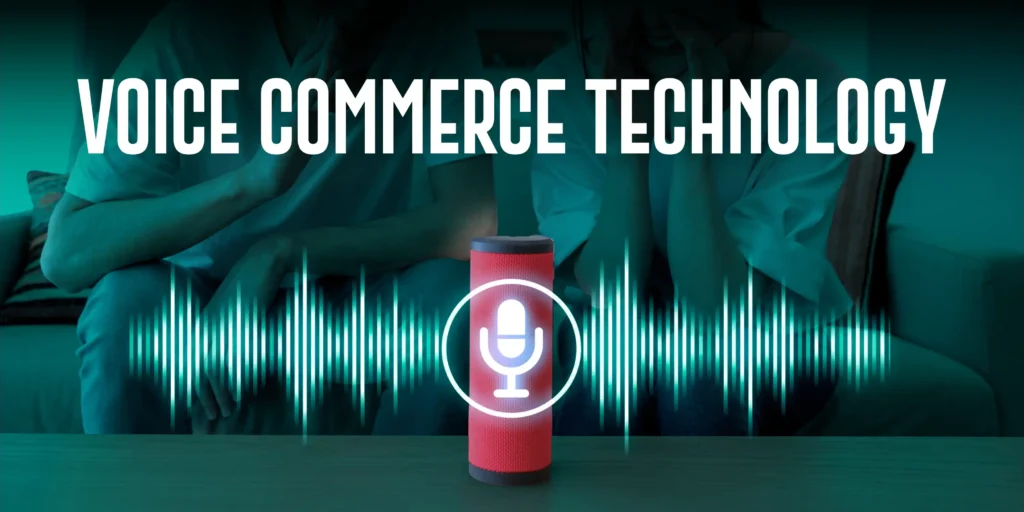Discover the future of shopping with voice commerce technology, offering convenience, personalization, and seamless interactions for modern consumers.
Voice commerce, sometimes called voice shopping, is using voice commands to make purchases through mobile apps, smart speakers, and virtual assistants.
We will look at voice commerce technology in this blog article, along with its advantages, disadvantages, and predictions for the future of commerce.
What is Voice Commerce?
A type of online shopping known as voice commerce helps customers explore, search for products, add items to their basket, and finish transactions by speaking commands.
To understand and reply to user requests, this technology makes use of voice recognition, natural language processing (NLP), and artificial intelligence (AI).

Apple Home Pod with Siri, Google Home with Google Assistant, Amazon Echo with Alexa, and many smartphone apps with speech search features are well-known voice-enabled devices that support it.
How Does Voice Commerce Work?
When a user utilizes a voice-activated app or device, the technology recognizes and understands the voice instructions, processes them, and performs the appropriate actions. Saying, “Hey Alexa, order a new pair of sneakers,” for example, will trigger Alexa to look for the desired item, present options, validate the purchase, and, if the user grants permission, handle the payment. Secure payment gateways and authentication techniques are used by voice commerce technologies to ensure convenient and safe transactions.
Benefits
Convenience: Voice commerce provides a hands-free purchasing experience, making it simple for customers to make purchases while managing other tasks or traveling.
Accessibility: A larger audience can shop with greater diversity and ease because of voice-activated devices that accommodate individuals with limits or abilities.
Personalization: To improve the purchasing experience, AI systems analyse customer preferences and previous exchanges to generate customized deals and recommendations.
Efficiency: Using voice commands to shop improves the process and cuts down on the time and processes needed to locate and buy desired items.
Integration: It helps companies take advantage of their current infrastructure and connect easily with payment processors and e-commerce platforms.
Challenges and Considerations
Accuracy: Voice recognition software can have difficulty understanding specific commands, accents, or background noise, which could result in mistakes or miscommunications.
Security: To promote user confidence and trust, voice commerce platforms need to take into consideration the protection of user data, payment information, and safe transactions.
User Experience: To provide a smooth and satisfying user experience, it is important to design user-friendly interfaces, optimize voice search engines, and provide precise feedback.
Adoption: Handling privacy issues and educating consumers about the advantages and possibilities of voice commerce are important variables that affect user acceptance and adoption rates.
The Future of Shopping
Voice commerce is set to play a major role in the retail industry as technology develops more. Experts in the field predict a significant spike in the use of voice shopping, due to improvements in artificial intelligence, the accuracy of voice recognition, and the growing popularity of voice-activated gadgets. The following major developments will influence voice commerce shopping in the future.
Integration with Smart Homes: Voice-activated gadgets are being progressively included in ecosystems for smart homes, giving users smooth access to specific suggestions, smooth appliance control, and order placement.
AI-Powered Assistants: With the help of AI algorithms, virtual assistants will be able to understand and predict what a customer wants with more expertise, which will improve voice shopping experiences’ simplicity and personalization.
Voice-Activated Payments: As voice biometrics and identification become more popular, secure and easy voice-activated payment solutions will become more popular, providing a smooth checkout experience.
Integration of Augmented Reality (AR): When voice commerce and AR technology combine, customers can see products, experience virtual samples, and make well-informed judgments about what to buy.
Adopting in the Business World
Adopting voice commerce provides sellers and businesses the chance to stand out in a crowded market, engage customers, and increase sales. The following are some methods for successfully utilizing voice commerce.
Optimize for Voice Search: Make sure that product descriptions, keywords, and content are voice-search-friendly by considering possible vocal search words from users.
Enhance Product Discovery: To help customers in their purchasing process, utilize voice-based product recommendations, cross-selling, and upselling techniques.
Provide Voice-Exclusive Offers: To promote adoption and loyalty, develop special discounts and promotions just for voice commerce users.
Focus on user experience first: To create an effortless and enjoyable purchasing experience, giving top priority to voice interfaces that are easy to use, clear instructions, and timely feedback.
Ensure Security and Privacy: To protect user information and build confidence, set to use strong security measures, data encryption, and clear privacy rules.
FAQS
The term “voice commerce” reflects the act of making online purchases using voice-activated gadgets like virtual assistants or smart speakers. With voice commands, users can shop and finish transactions.
Benefits include hands-free shopping, accessibility for visually impaired users, convenience for multitasking, and personalized shopping experiences through AI-driven recommendations.
Voice commerce platforms prioritize security with features like voice recognition, authentication protocols, and encrypted transactions to safeguard user data and financial information.
Conclusion
Voice commerce technology is a game-changer for how customers connect with brands and make decisions about what to buy. Because of the way it combines accessibility, personalization, and convenience, voice commerce could change the way people purchase in the future.
Businesses can stay ahead of the curve, satisfy changing customer expectations, and create memorable shopping experiences that are attractive to today’s tech-savvy and convenience-seeking consumers by adopting and innovating with voice commerce solutions.
